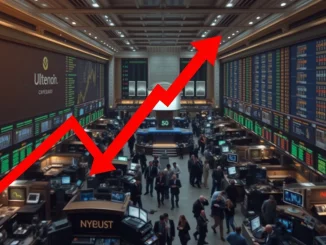
Buckle up, folks! The stock market just took a serious nosedive. Today’s trading session witnessed a dramatic Nasdaq fall, sending shockwaves through the financial world. If you’re tracking the markets, you know volatility is part of the game, but a 4% drop? That’s a jolt! Let’s dive into what’s happening and what it could mean for you.
What Triggered This Shocking Nasdaq Fall?
The tech-heavy Nasdaq Composite Index experienced a significant Nasdaq fall of 4.05% during today’s trading. This wasn’t an isolated incident; the broader market is feeling the pressure too. The S&P 500 index is currently down 2.57%, and the Dow Jones Industrial Average is also feeling the heat, down by 1.57%. So, what’s behind this widespread market downturn?
- Economic Uncertainty: Global economic outlook remains uncertain. Factors like inflation, rising interest rates, and geopolitical tensions are casting a shadow over investor sentiment.
- Inflation Concerns: Persistent inflation is a major worry. Investors are concerned about whether central banks can effectively manage inflation without triggering a recession.
- Interest Rate Hikes: To combat inflation, central banks are raising interest rates. While necessary, higher rates can make borrowing more expensive for companies and consumers, potentially slowing down economic growth.
- Profit-Taking: After periods of market gains, investors often engage in profit-taking, selling off some of their holdings, which can contribute to market declines.
The Domino Effect: S&P 500 Down and Dow Jones Decline
It’s not just the Nasdaq feeling the pinch. The S&P 500 down by 2.57% signifies a broad market correction. The S&P 500 is considered a benchmark for the overall U.S. stock market, representing 500 of the largest publicly traded companies. A significant drop here indicates widespread selling pressure across various sectors.
Similarly, the Dow Jones decline of 1.57% shows that even established, blue-chip companies are not immune to the current market anxieties. The Dow Jones, while narrower in scope than the S&P 500, tracks 30 major U.S. companies and is a key indicator of market health.
Decoding Investor Fear in This Market Sell-Off
The sharp declines across these major indices point to a significant surge in investor fear. Market sentiment can shift rapidly, and when fear takes hold, it can lead to a rapid stock market crash or correction. Several factors contribute to this fear:
- Volatility Spike: Increased market volatility itself can breed fear. When prices fluctuate wildly, investors become more risk-averse.
- Negative News Cycle: A constant stream of negative economic news or geopolitical uncertainty can amplify fear and trigger sell-offs.
- Margin Calls: In leveraged trading, a market downturn can trigger margin calls, forcing investors to sell assets to cover their positions, further exacerbating the decline.
- Herd Mentality: Fear can be contagious. When investors see others selling, they may panic and follow suit, creating a self-reinforcing downward spiral.
Is This a Stock Market Crash or a Correction?
While a 4% Nasdaq fall is undoubtedly significant, it’s crucial to differentiate between a market correction and a full-blown stock market crash. A correction is typically defined as a 10% to 20% decline from a recent high, while a crash is a more severe and rapid downturn.
Currently, we are witnessing a significant correction across major indices. Whether it escalates into a full-blown crash depends on various factors, including:
| Factor | Potential Impact on Market |
|---|---|
| Economic Data Releases | Positive data could ease fears; negative data could worsen the sell-off. |
| Central Bank Actions | Aggressive rate hikes could increase recession risks; dovish signals might calm markets. |
| Geopolitical Events | Escalations could trigger further market declines; de-escalation could provide relief. |
| Corporate Earnings | Strong earnings could offer support; weak earnings could amplify negative sentiment. |
Navigating the Market Sell-Off: Actionable Insights
So, what should investors do amidst this market sell-off and Nasdaq fall?
- Stay Calm: Emotional reactions can lead to poor investment decisions. Avoid panic selling.
- Review Your Portfolio: Assess your risk tolerance and portfolio allocation. Ensure it aligns with your long-term financial goals.
- Consider Dollar-Cost Averaging: For long-term investors, market downturns can present opportunities to buy quality assets at lower prices through dollar-cost averaging.
- Seek Professional Advice: If you’re unsure how to navigate the current market environment, consult with a financial advisor.
- Focus on Long-Term Fundamentals: Remember that market cycles are normal. Focus on the long-term fundamentals of your investments rather than short-term volatility.
In Conclusion: Weathering the Storm of Investor Fear
Today’s Nasdaq fall and the broader stock market crash signals are a stark reminder of the inherent volatility in financial markets. Investor fear is palpable, driving the S&P 500 down and contributing to the Dow Jones decline. While unsettling, market corrections are a natural part of the economic cycle. By staying informed, maintaining a long-term perspective, and avoiding impulsive decisions, investors can navigate these turbulent times and position themselves for future growth. Keep a close eye on market developments, stay informed, and remember that even in the face of a stock market crash, opportunities can emerge for those who remain patient and strategic.



